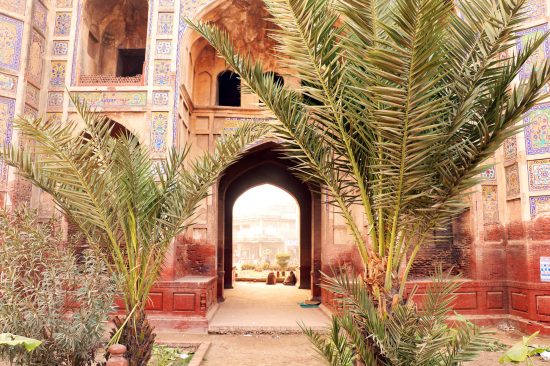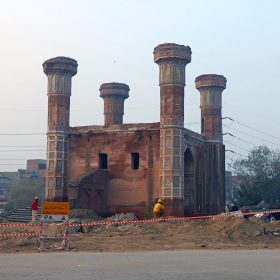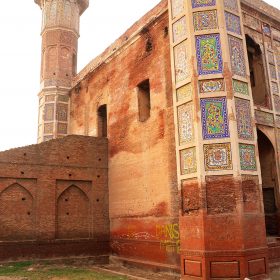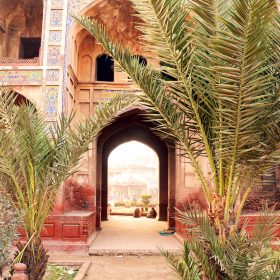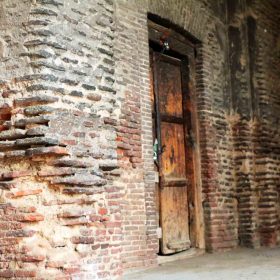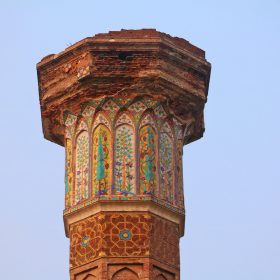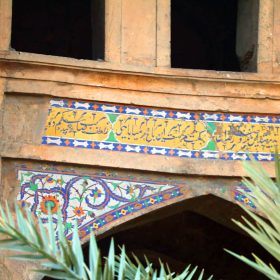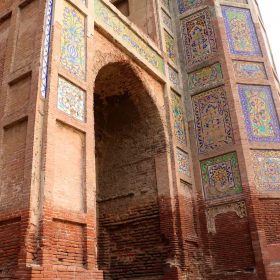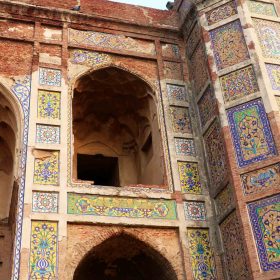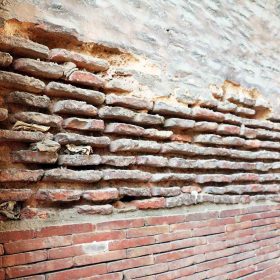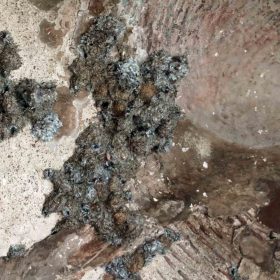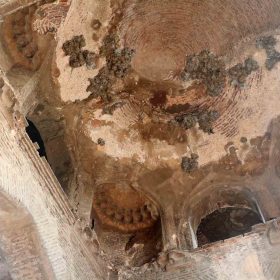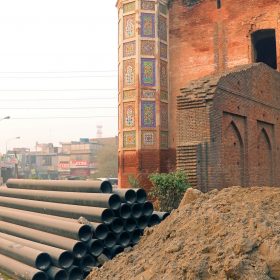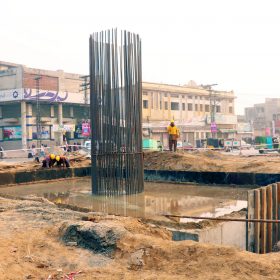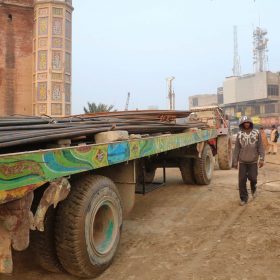As a former “resident” of Pakistan, I am always interested in historic buildings and the stories that anchor them to the region. In 2016 I went to Chauburji Gate and found out that history and progress collide at some point in the growth of a city. However, this architecture has already seen its share of neglect long before the scheduled railway was planned.
Currently, the entire structure is surrounded by construction equipment. Flatbed trucks bringing in large piping and steal beams keep repel visitors, except for the transients sleeping in and around, despite the noise and heavy work taking place. Not trying to sound negative, just painting a realistic picture.
The gate is basically in the middle of what is now an involuntary roundabout. In fact, the entire area was not well-thought out, in my opinion, in that the city planners would dare to think that putting an historic structure in the center of a roundabout would be of any convenience to tourists. Seriously, I can’t say enough bad things about the horrible drivers with no regard to pedestrians. Again, I’m not trying to sound negative here, but as a tourist/resident it makes going to these places virtually death defying. Crossing a street over there is like playing human Frogger.
All that aside, the structure is still amazing with its own merits. One being that it was built in 1646.
Here is a little background:
The very word “Chauburji”, meaning “Four Towers” in Urdu, is likely a modern term for what would have been merely a monumental gateway to the vast garden at the site in the Mughal era. Due to flooding and neglect, the garden may not have long survived its completion. By the 19th century the monument was somewhat dilapidated, having lost its northwest tower to an earthquake in 1846. In the 1960s the Department of Archaeology supervised the reconstruction of the destroyed tower and also restored the surviving parts of the monument.
The design of the minarets with their distinctive flairing capitals is a stylistic variant found only in Lahore.
Click here to read the entire article posted on the Asian Historical Architecture website.
When we were getting close to the area we could see the columns towering over the surrounding buildings. As we got even closer we had a hard time finding a place to park so we could cross the street at the roundabout. Still, the size of the structure is impressive. I am not sure why a city with such a rich history would not have a functioning historic society that oversees the upkeep of this kind of architecture.
Once we got to the structure itself, the complexity of the glasswork was stunning. The bright colors against the red brick created a bright contrast that made the workmanship stand out. A great amount of the mosaics are now either missing pieces or covered up by dirt from the construction. After we got into the center of the structure Waqas pointed out the ceiling where the Ababil or Swallow had made their nests. I had never seen this kind of bird nest before but I find it appropriate that this bird would make its home in this location because of the height of the ceiling.
One of the hallmark features is the script written above the doorway. It’s written in Arabic and reads Ayat-ul-Kursi, which means the Verse of the Throne, taken from the Quran in verse 255 of the second chapter (The Chapter of the Cow). In addition, there is another inscription as cited from the Asian Historical Architecture site:
An inscription on the monument gives the date 1056 AH (1646) and attributes it to “Sahib-e-Zebinda Begam-e-Dauran”. According to the 19th century historian Syad Muhammad Latif, the full inscription reads:
“This garden, in the pattern of the garden of paradise, has been founded…
(the second line has been effaced)
The garden has been bestowed on Mian Bai
By the bounty of Zebinda Begam, the lady of the age”.
The Ababil/Swallow’s Nest
The common swallow, also referred to as the ababil, has many species of Genus Hirundo. It is so named because of typical deeply forked “swallow” tail. It builds clay nest on lower portion of old and dilapidated buildings as well as old bridges.
It collects moist soil from banks of streams and rivers atc. and conglomerates it in shape of a nest with one hole-like opening. Their colony consists of numerous nests . It is really a wonder , how every individual bird identifies its nest, as well as the young , to which the bird feeds very frequently through out the day.
Source: YouTube User / Ajay Sharma
Is there is a downside to the railway?
I have personally been to this area and my initial thought is that this is a colossal mistake just because it is taking a long time to complete. I looked around the internet and found this article from February 13, 2013. It seems like there should have been a lot more progress in a 3 year time span, but that’s just my lack of knowledge talking.
The Good, Bad and Ugly of Lahore Metro
What is with Sharif family’s indefatigable obsession with transport, more elaborately, means of transport? First, they pioneered the yellow cab taxi scheme in early 90’s that called for rounds of applause. Then, in late 90’s, famous Lahore-Islamabad motorway hit the headlines and this time Lahore Metro is one scintillating star.
Interestingly, all of the above mentioned projects spear headed by Sharif brothers created much stir and hype among the masses and classes. Where, these flagship projects of PML (N) were applauded by one segment of society while at the same time invited massive criticism from various quarters depending upon their bend of mind.
However, as a resident of Lahore and a keen observer I had seen the Lahore Metro Project unfolding before my eyes like a giant coiled python made of steel and cement.
Out of about 10 million residents, the project must have agitated each resident of Lahore at least once in its eleven-month construction time. So, naturally, there are a few good, bad and ugly facets of the project. Let’s evaluate them as per our own individual discretion.
The author goes on to list 5 pros and 5 cons to the project. At the time I visited the structure I had not lived there very long but I am the type of person that would rule on the side of protecting and preserving the historical structures of a city, since those are the very things that people like me are the most interested in seeing when I visit a country outside my home country. It isn’t just that there is so much construction around this particular structure, it’s that way too many areas are under some sort of road construction. It’s a menace to the city’s residents and deters tourism.
In conclusion, I found the history more appealing than the physical appearance of the architecture. It was difficult to get professional looking photos but I hope you enjoy them anyway. Let me know your thoughts and if you’re a Lahorian, please put your two cents in so we can understand the method behind this madness. Please like and share. Thanks.
All photos were taken by Melody Paxton in Lahore Pakistan, 2016. No unauthorized use. Available by request only. To request permission, use the Contact Form.

